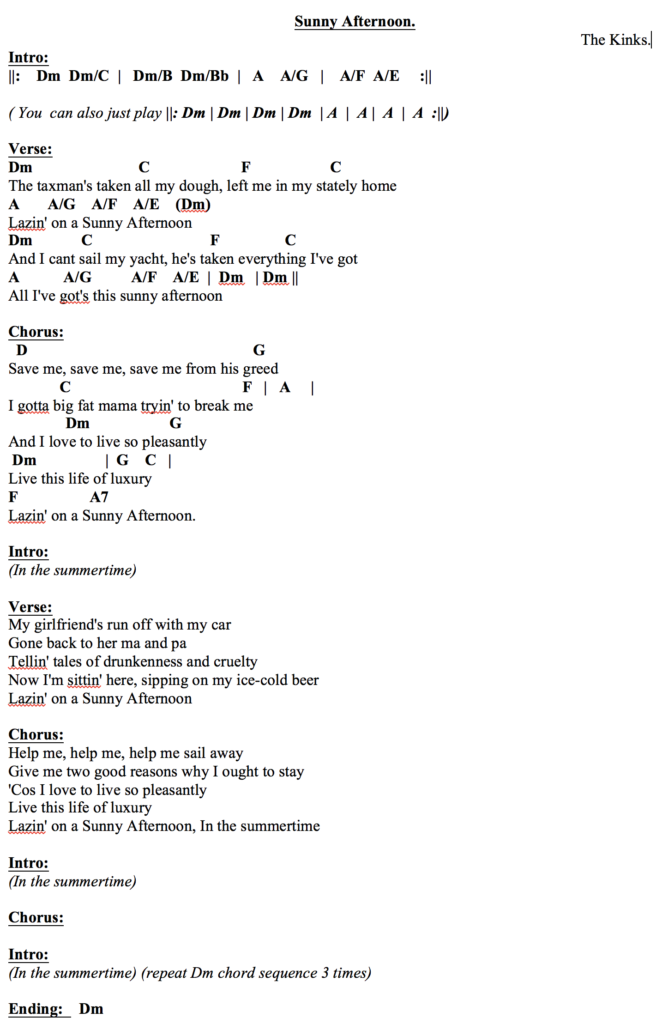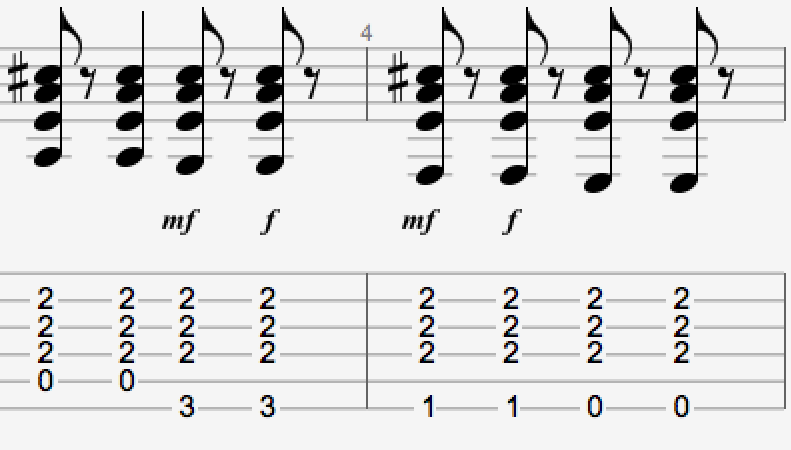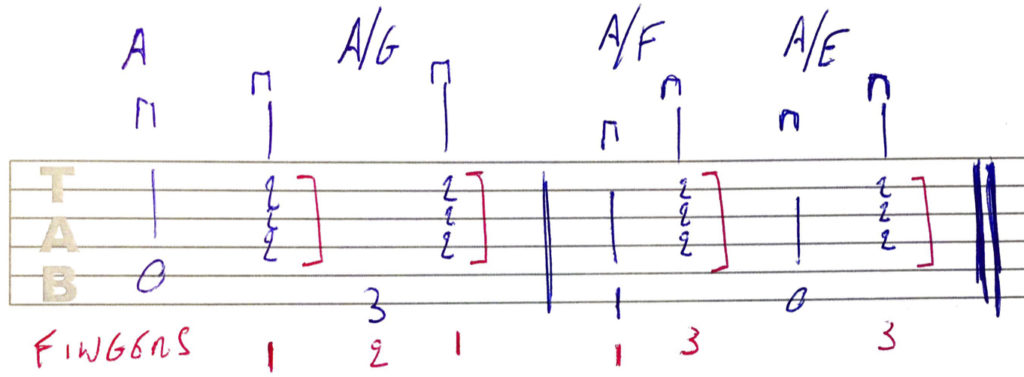How To Play The Kinks “Sunny Afternoon”
This is a really well-written song.
The song incorporates interesting composition techniques, has great melodies, a nice rhythmic groove, it modulates back and forth between the keys of D minor and D major, has nice bass lines, hybrid chords, great instrumentation… a little bit of everything.
You can hear the song here:
This is the chord chart

You can download the song chord chart here.
Analysis of The Kinks “Sunny Afternoon”
Form and Structure:
3 song sections
- Intro
- Verse
- Chorus
Intro
The intro consists of an instrumental 4-bar bass melody, played in quarter notes.
That melody is a scalar descending line, walking down a D minor scale, with a chromatic passing note (B) between the b7 (C) and the b6 (Bb)
The chords: 2 bars Im (Dm) and 2 bars V (A) chord.
Ending the intro on the V chord (which wants to resolve to I), sets it up to strongly move forward into the following verse, which starts on the I chord (Dm).
There are 2 ways you can play this into on guitar.
- You can play the melody on a bass string.
This is how I teach my students how to play it.

Down strokes only, to give the bass melody a thick, full sound.
- You can play hybrid chords.
If you want to be more adventurous, you could also play this intro with hybrid chords.
In this approach, you combine that bass melody and the chords. This is how it looks like.
The hybrid chord approach is a bit of a dexterity exercise also.
Verse
The verse is 14 bars long. It’s in the key of Dm.
||: Dm | C | F | C | A A/G | A/F A/E :|| Dm | Dm |
Chord analysis
||: Im | bVII | bIII | bVII | V | V :|| Im | Im ||
In the first 4 bars: the strumming rhythm that best complements the groove is down down up up down up

This is probably THE most used guitar strum rhythm.
The next 2 bars, 5 and 6, are the same part that the intro ends on.
It’s little things like this, that show great writing and composition skill.
This reoccurring scalar descending bass melody and chord theme, nicely tie the song together.

In those 2 bars of A (bars 5 and 6), you want to switch to a different strum style.
You want that walking bass melody to really stand out here.
The way you do this: don’t strum the whole chord, but hit the bass melody note, followed by the chord.
Down strokes only, quarter note rhythm:
Hit A bass note, then the A chord
Hit G bass note, then the A chord
Hit F bass note, then the A chord
Hit E bass note, then the A chord
Here’s how that looks like with music notation.

In the first A chord measure, the A chord is played with the pointy finger barring the 2nd fret on the D, G and B strings.
In the next measure, switch to playing the A chord with (barred) ring finger, so you have your pointy finger free to play the F bass note on the first fret.
The switch into that A/F chord is a switch that many students find challenging.
The verse ends on 2 bars of Dm.
Chorus
Here we have a key change.
The chorus is in the key of D (major)
Coming from the D minor verse, we get a sense of opening up, an uplifting feeling, going into the major key chorus.
Another song that comes to mind that switches between parallel (staying on the same letter) minor and major keys, is The Beatles “While My Guitar Gently Weeps”, which switches between the keys of A minor and A major.
The 2nd half of the chorus switches back to D minor, flirting with the major/minor tonality.
Interesting to note: while verses and choruses are usually 8 or 16 bars long, the verse and chorus in this song are both 14-bar song sections.
The chords:
D | D | G | G
C | C | F | A
Dm | G | Dm | G C |
F | A7 |
Chord Analysis
I | I | IV | IV
bVII | bVII | bIII | V
Im | IV | Im | IV bVII
bIII | V7
Notice how the chorus ends on the V dominant chord, propelling the song forward into the I chord of the intro that comes right after.
Hope you enjoyed this analysis and that you learned a lot that you can use in your own songwriting.
Here’s a helpful video
Conclusion
Hit me up anytime at vreny@zotzinmusic.com if you have any questions, or if you would like to book a lesson.
These free lessons are cool, but you will never experience the progress, joy, and results that my students experience in lessons when you’re learning by yourself from blogs and videos.
That is why people take lessons: way better results and progress, much more complete information, exposed to way more creative ideas than you can get from a blog or YouTube video.
There is only so much that self-study can accomplish.
If you want to see amazing results and progress in your guitar playing, buy your first lesson here and get started ASAP.
You’ll impress your friends and loved ones in no time with your guitar playing!
Consider donating any small amount to help me keep this blog going.
Thank you for your support!


